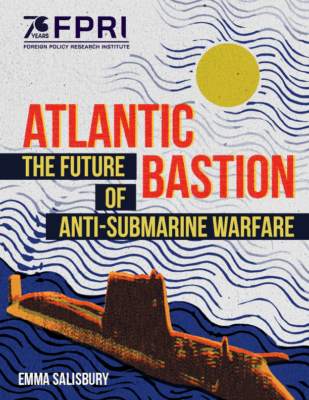A nation must think before it acts.
Atlantic Bastion represents the Royal Navy’s future plan for anti-submarine capabilities, defending the North Atlantic against the threat from the Russian submarine fleet. First formally revealed in the United Kingdom’s recent Strategic Defence Review, the program brings in emerging technologies to achieve persistent situational awareness in what is an extremely complex maritime domain. This is intended to enhance British anti-submarine warfare (ASW) capabilities, a vital component of European collective defense. The concept envisions a layered and integrated sensor network that spans surface, subsurface, and aerial domains and is coordinated across multiple stakeholders. When fully implemented, the project aims to bolster the Royal Navy’s capacity to detect, track, and deter submarines across the North Atlantic, particularly around the vital GIUK (Greenland-Iceland-UK) gap.
The Royal Navy will field a technologically advanced force centered around the Type 26-class ASW frigate, designed with modular mission bays to enable agile upgrades and iterative capability development, complemented by uncrewed surface and underwater vehicles. These assets will be fused with AI-enabled acoustic detection systems and integrated within a broader digital targeting network to enhance situational awareness and accelerate targeting processes. Atlantic Bastion aims to enhance maritime surveillance, free up crewed warships for other missions, and fulfill an evolving strategic requirement to protect sea lines of communication and counter the threat from the Russian submarine fleet.
The first phase, ATLANTIC NET, is focused on delivering “ASW as a service.” This will be achieved through a Contractor Owned, Contractor Operated, Naval Oversight (COCONO) model, in which a consortium of industry partners manages lean-crewed, remotely operated, or autonomous systems that collect acoustic and sensor data across designated maritime domains. Algorithms will process and triage this data, which will then be transmitted securely to a Royal Navy-run Remote Operations Centre for further analysis. This approach is designed to increase maritime awareness while freeing up high-value crewed Royal Navy platforms for other critical missions – the goal is to achieve greater mass in ASW surveillance while retaining the Royal Navy’s strategic flexibility.
The second phase, originally titled BASTION ATLANTIC, moves from the COCONO model to a more traditional Government Owned, Government Operated (GOGO) framework. The Royal Navy would directly own and operate a force of uncrewed and autonomous platforms, supplemented by sensors and effectors designed to allow persistent capabilities in-theater. Two specific platforms have already been identified as part of this phase: the Type 92 class sloop, an ASW Uncrewed Surface Vessel (USV), and the Type 93 class chariot, an advanced XLUUV. Additionally, this phase will integrate other technologies currently under development within the UK defense sector.
Atlantic Bastion will thus be an ecosystem of its own, a mix of airborne, surface, and subsurface systems that work together to provide ASW capability.
The Future of Atlantic Bastion
Atlantic Bastion aims to achieve persistent situational awareness across a complex and geographically expansive maritime domain. This is both a formidable challenge and a remarkable opportunity for the Royal Navy, as well as for the British defense-industrial base. Success will depend on an adaptive approach to deployment, striking the right balance between technological innovation and operational pragmatism.
Atlantic Bastion is more open than its predecessor, SOSUS – although many of the intricacies of the technology will remain behind closed doors, the project itself is public. It will not be difficult for Russia to guess where much of the hardware is, or to find it through surveillance. While this openness does allow for Atlantic Bastion to have a deterrent effect, which is important, it will need to be protected in a way that SOSUS was not, adding to the challenge (and the expense) of the project. If parts of the network are attritted, there will also need to be robust plans in place to replace assets to ensure that no gaps in coverage persist to be exploited.
A central problem will be the environmental conditions within which Atlantic Bastion will need to operate. As well as managing the known effect on ASW capabilities from oceanographic variables, the harsh and variable weather conditions of the North Atlantic will pose particular challenges to lightweight UUVs. Combined with what will be likely to be a requirement for lengthy operations and/or persistent presence, Atlantic Bastion will need to emphasize reliability, durability, and endurance in the UUV systems that become part of its eventual make-up.
Perhaps the most daunting challenge, however, is the handling of data at scale – a challenge shared by a broad range of military systems throughout the present and near future. Naval systems already generate vast amounts of information, and the expansion of capabilities under Atlantic Bastion will only exacerbate this. The fusion, processing, and exploitation of this data will require advanced analytics tools and processing frameworks that are secure, responsive and operationally effective – collecting data is pointless unless it can be parsed and used effectively.
It is also unclear at present what role NATO allies will play in Atlantic Bastion. How does this proposal fit in with allied navies’ ASW operations in the same theater? Would NATO allies like Norway or France want to contribute? What kind of coordination agreements will be in place? Given that ASW in the North Atlantic is a common goal to defend European NATO allies from Russian submarines, it would seem beneficial to have considerable collaboration on a project such as this.
The solutions to the problems behind Atlantic Bastion will depend on evolving technological capabilities. There is a strong techno-optimistic temptation to assume that these capabilities will be smoothly developed, fielded, and maintained through the innovative process, but we must recognize that this is a bet that may not pay off. The combination of the complexity of the project itself, the importance of persistent ASW coverage in the North Atlantic and the tendency of all military innovation to not go as planned may lead to failure if significant resilience and redundancies are not built into the project from the beginning. Atlantic Bastion, in this regard, is as much a test of foresight and collaboration as it is of engineering excellence.
If these problems are solved or avoided, however, Atlantic Bastion will provide a resilient and much needed ASW capability in the North Atlantic, which is increasingly vital for defending the United Kingdom and NATO allies. A bet it may be, but it is one that the United Kingdom should take.
Image: UK Prime Minister Sir Keir Starmer aboard a nuclear-armed submarine, March 2025. (Simon Dawson/UK Crown Copyright/ via Reuters Connect)





